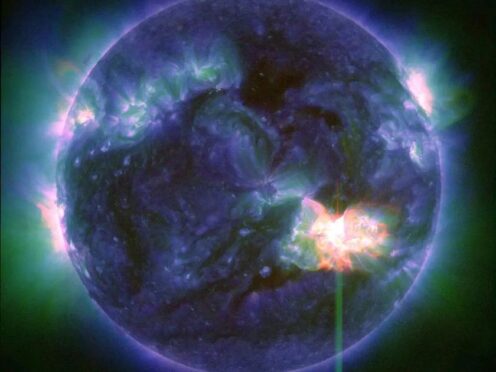
An unusually strong solar storm could produce northern lights in the US this weekend and potentially disrupt power and communications.
The National Oceanic and Atmospheric Administration (NOAA) issued a rare severe geomagnetic storm warning when a solar outburst reached Earth on Friday afternoon, hours sooner than anticipated.
The effects were due to last through the weekend and possibly into next week.
The NOAA alerted operators of power plants and spacecraft in orbit to take precautions, as well as the Federal Emergency Management Agency.
“For most people here on planet Earth, they won’t have to do anything,” said Rob Steenburgh, a scientist with the NOAA’s Space Weather Prediction Centre.
The storm could produce northern lights as far south in the US as Alabama and northern California, according to the NOAA.
But it was hard to predict and experts stressed it would not be the dramatic curtains of colour normally associated with the northern lights, but more like splashes of greenish hues.
“That’s really the gift from space weather – the aurora,” said Mr Steenburgh.
He and his colleagues said the best aurora views may come from phone cameras, which are better at capturing light than the naked eye.
Snap a picture of the sky and “there might be actually a nice little treat there for you”, said Mike Bettwy, operations chief for the prediction centre.
The most intense solar storm in recorded history, in 1859, prompted auroras in central America and possibly even Hawaii.
The Space Weather Prediction Center has issued the first G4 (Severe) geomagnetic watch since 2005. The aurora tonight/tomorrow morning may become visible over much of the northern half of the country, and maybe as far south as Alabama to northern California.Story:… pic.twitter.com/wbeRbnqD6E
— National Weather Service (@NWS) May 10, 2024
“We are not anticipating that” but it could come close, said NOAA space weather forecaster Shawn Dahl.
This storm – ranked 4 on a scale of 1 to 5 – poses a risk for high-voltage transmission lines for power grids, not the electrical lines ordinarily found in people’s homes, Mr Dahl told reporters.
Satellites could also be affected, which in turn could disrupt navigation and communication services here on Earth.
An extreme geomagnetic storm in 2003, for example, took out power in Sweden and damaged power transformers in South Africa.
Even when the storm is over, signals between GPS satellites and ground receivers could be scrambled or lost, according to the NOAA.
But there are so many navigation satellites that any outages should not last long, Mr Steenburgh noted.
The sun has produced strong solar flares since Wednesday, resulting in at least seven outbursts of plasma.
Each eruption – known as a coronal mass ejection – can contain billions of tons of plasma and magnetic field from the sun’s outer atmosphere, or corona.
Large sunspot groups and strong solar flares led to the issuance of SWPC's first G4 Watch since 2005… pic.twitter.com/oi55cTPXhP
— NOAA Space Weather Prediction Center (@NWSSWPC) May 9, 2024
The flares seem to be associated with a sunspot that is 16 times the diameter of Earth, according to the NOAA.
It is all part of the solar activity that is ramping up as the sun approaches the peak of its 11-year cycle.
Nasa said the storm posed no serious threat to the seven astronauts aboard the International Space Station.
The biggest concern is the increased radiation levels, and the crew could move to a better shielded part of the station if necessary, according to Mr Steenburgh.
Increased radiation could also threaten some of Nasa’s science satellites.
Extremely sensitive instruments will be turned off, if necessary, to avoid damage, said Antti Pulkkinen, director of the space agency’s heliophysics science division.
Several sun-focused spacecraft are monitoring all the action.
“This is exactly the kinds of things we want to observe,” Mr Pulkkinen said.

Enjoy the convenience of having The Sunday Post delivered as a digital ePaper straight to your smartphone, tablet or computer.
Subscribe for only £5.49 a month and enjoy all the benefits of the printed paper as a digital replica.
Subscribe